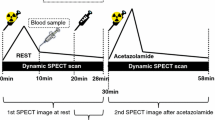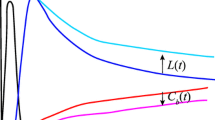Abstract
Objective
When N-isopropyl-4-iodoamphetamine (123I-IMP) single-photon emission computed tomography (SPECT) studies at rest and after acetazolamide (ACZ) challenge are conducted in a day, the time-dependent change in IMP in the brain at rest should be estimated accurately. We devised the method and investigated whether our one-day method for measuring the rate of increase in SPECT counts allowed reduction in the acquisition time.
Methods
Sequential, 5-min SPECT scans were performed. We estimated the time-dependent change in the brain using the change in slopes of two linear equations derived from the first three SPECT counts. For the oneday method, ACZ was administered 15 min or 20 min after IMP administration. The second IMP was administered 10 min after ACZ administration.
Results
Time-dependent changes in the brain were classified into 13 patterns when estimation was started at 5 min after IMP administration and 6 patterns when estimation was started at 10 min, and fitting coefficients were determined. The correlation between actual measurements at 37.5 min and estimates was high with a correlation coefficient of 0.99 or greater. Rates of increase obtained from 20-min data were highly correlated with those obtained from 15-min or 10-min data (r = 0.97 or greater). In patients with unilateral cerebrovascular disease, the rate of increase on the unaffected side was 44.4 ± 10.9% when ACZ was administered 15 min later and 48.0 ± 16.0% when ACZ was administered 20 min later, and the rates of increase with different timings of administration were not significantly different.
Conclusions
The examination time may be reduced from 50 min to 45 min or 40 min as needed. The rate of increase was not influenced by the time frame for determination or the timing of ACZ administration. These findings suggest that our estimation method is accurate and versatile.
Similar content being viewed by others
References
Kuhl DE, Barrio JR, Huang SC, Selin S, Ackermann RF, Lear JL, et al. Quantifying local cerebral blood flow by Nisopropyl-p-[123I] iodoamphetamine (IMP) tomography. J Nucl Med 1982;23:196–203.
Matsuda H, Seki H, Ishida H, Sumiya H, Tsuji S, Hisada K, et al. Regional cerebral blood flow measurement using Nisopropyl-p-[123I] iodoamphetamine and rotating gamma camera emission computed tomography. Kaku Igaku 1985;22:9–18.
Iida H, Itou H, Nakazawa M, Hatazawa J, Nishimura H, Onishi Y, et al. Quantitative mapping of regional cerebral blood flow using Iodine-123-IMP and SPECT. J Nucl Med 1994;35:2019–2030.
Ito H, Ishii K, Kinoshita T, Koyama M, Kawashima R, Ono S, et al. Normal CBF values by the ARG method using IMP SPECT: Comparison with a conventional microsphere model method. Kaku Igaku 1996;33:175–178.
Hashikawa K, Matsumoto M, Moriwaki H, Oku N, Okazaki Y, Uehara T et al. Split dose Iodine-123-IMP SPECT: Sequential quantitative regional cerebral blood flow change with pharmacological intervention. J Nucl Med 1994;35:1226–1233.
Nishizawa S, Yonekura Y, Tanaka F, Fujita T, Tsuchimochi S, Ishizu K, et al. Evaluation of a double-injection method for sequential measurement of cerebral blood flow with iodine-123-iodoamphetamine. J Nucl Med 1995;36:1339–1345.
Inoue T, Fujioka H, Akamune A, Tanada S, Hamamoto K. A time-saving approach for quantifying regional cerebral blood flow and application to split-dose method with 123I-IMP SPECT using a single-head rotating gamma-camera. Kaku Igaku 1995;32:1217–1226.
Nishizawa S, Iida H, Tsuchida T, Ito H, Konishi J, Yonekura Y. Validation of the dual-table autoradiographic method to quantify two sequential rCBFs in a single SPET session with N-isopropyl-[123I]p-iodoamphetamine. Eur J Nucl Med Mol Imaging 2003;30:943–950.
Iida H, Akutsu T, Endo K, Fukuda H, Inoue T, Ito H, et al. A multicenter validation of regional cerebral blood flow quantitation using [123I] iodoamphetamine and single photon emission computed. J Cereb Blood Flow Metab 1996;16:781–793.
Kawamura Y. Estimation by static SPECT of the radioactivity remaining after the first dose of two-fractionated 123I-IMP administration: The rate of increase in cerebral blood flow by ARG and the rate of increase in SPECT count. Kaku Igaku 2002;39:125–134.
Takeuchi R, Yonekura Y, Matsuda H, Konishi J. Usefulness of a three-dimensional stereotaxic ROI template on anatomically standardized 99mTc-ECD SPECT. J Nucl Med Mol Imaging 2002;29:331–341.
Author information
Authors and Affiliations
Corresponding author
Rights and permissions
About this article
Cite this article
Kawamura, Y., Ashizaki, M., Saida, S. et al. Usefulness of rate of increase in SPECT counts in one-day method of N-isopropyl-4-iodoamphetamine [123I] SPECT studies at rest and after acetazolamide challenge using a method for estimating time-dependent distribution at rest. Ann Nucl Med 22, 457–463 (2008). https://doi.org/10.1007/s12149-008-0134-3
Received:
Accepted:
Published:
Issue Date:
DOI: https://doi.org/10.1007/s12149-008-0134-3




